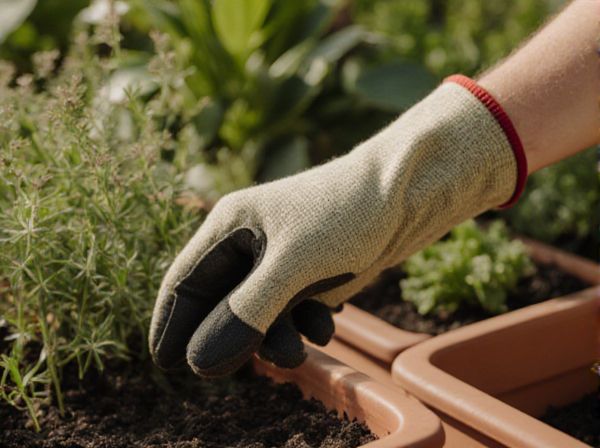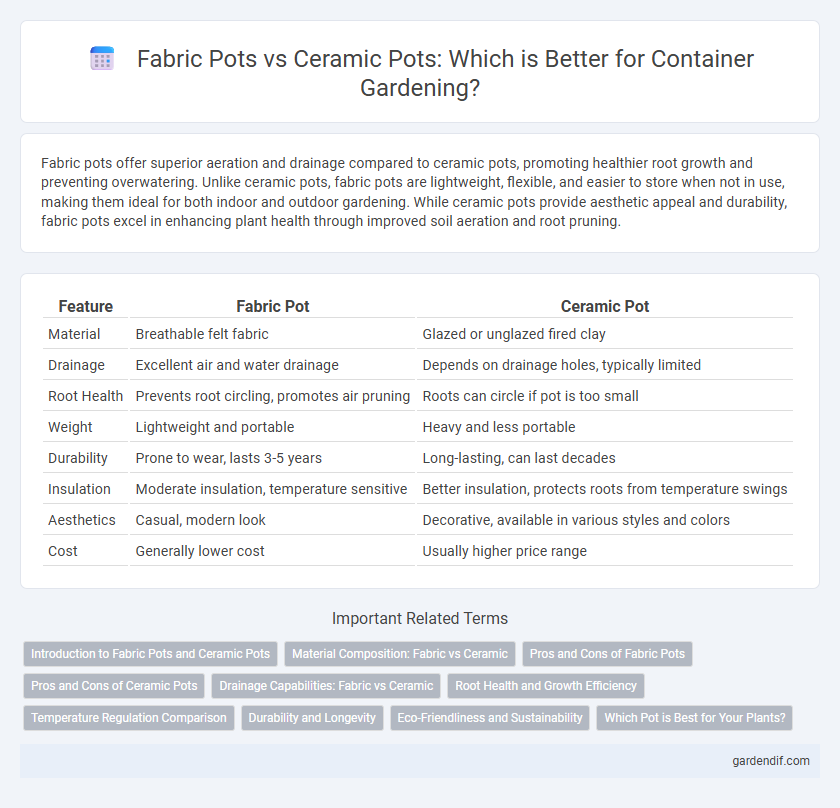
Fabric pot vs ceramic pot Illustration
Fabric pots offer superior aeration and drainage compared to ceramic pots, promoting healthier root growth and preventing overwatering. Unlike ceramic pots, fabric pots are lightweight, flexible, and easier to store when not in use, making them ideal for both indoor and outdoor gardening. While ceramic pots provide aesthetic appeal and durability, fabric pots excel in enhancing plant health through improved soil aeration and root pruning.
Table of Comparison
| Feature | Fabric Pot | Ceramic Pot |
|---|---|---|
| Material | Breathable felt fabric | Glazed or unglazed fired clay |
| Drainage | Excellent air and water drainage | Depends on drainage holes, typically limited |
| Root Health | Prevents root circling, promotes air pruning | Roots can circle if pot is too small |
| Weight | Lightweight and portable | Heavy and less portable |
| Durability | Prone to wear, lasts 3-5 years | Long-lasting, can last decades |
| Insulation | Moderate insulation, temperature sensitive | Better insulation, protects roots from temperature swings |
| Aesthetics | Casual, modern look | Decorative, available in various styles and colors |
| Cost | Generally lower cost | Usually higher price range |
Introduction to Fabric Pots and Ceramic Pots
Fabric pots are made from breathable, porous materials that promote air pruning of roots, improve drainage, and enhance oxygen flow, leading to healthier plant growth. Ceramic pots, typically glazed or unglazed clay, offer durability and aesthetic appeal while retaining moisture longer due to their dense structure. Choosing between fabric and ceramic pots depends on factors like plant type, watering frequency, and environmental conditions.
Material Composition: Fabric vs Ceramic
Fabric pots are made from breathable synthetic fibers such as polypropylene or polyester, allowing superior air circulation and drainage that promotes healthier root growth. Ceramic pots, typically composed of clay and fired at high temperatures, provide rigidity and moisture retention but may restrict airflow, potentially causing root rot if overwatered. The porous nature of fabric material contrasts sharply with the dense, non-porous ceramic structure, directly affecting soil aeration and moisture levels in container gardening.
Pros and Cons of Fabric Pots
Fabric pots offer excellent aeration and drainage, reducing root rot and promoting healthy root growth in container gardening. They are lightweight, portable, and foldable for easy storage but tend to dry out faster and may require more frequent watering than ceramic pots. Unlike ceramic pots, fabric pots are less durable and can degrade over time when exposed to harsh weather conditions.
Pros and Cons of Ceramic Pots
Ceramic pots offer excellent breathability and moisture retention, which promotes healthy root growth and prevents soil from drying out too quickly. They are durable and aesthetically pleasing, often available in various designs and colors suitable for both indoor and outdoor use. However, ceramic pots can be heavy and prone to cracking under extreme temperature changes, requiring careful handling and placement.
Drainage Capabilities: Fabric vs Ceramic
Fabric pots offer superior drainage capabilities compared to ceramic pots, allowing excess water to easily escape through the porous material, which prevents waterlogging and promotes healthier root aeration. Ceramic pots often have limited drainage holes and their non-porous surface can retain moisture, increasing the risk of root rot if not carefully managed. The breathability of fabric pots makes them ideal for plants requiring consistent moisture control and robust root development.
Root Health and Growth Efficiency
Fabric pots enhance root health by promoting superior aeration and preventing root circling through air pruning, leading to a more fibrous root system. Ceramic pots, while aesthetically pleasing and durable, often restrict airflow and drainage, potentially causing root rot and stunted growth. For optimal growth efficiency and robust root development, fabric pots provide a more breathable environment that encourages oxygen exchange and healthier root architecture.
Temperature Regulation Comparison
Fabric pots provide superior temperature regulation by allowing increased airflow and enhanced root zone oxygenation, which helps prevent overheating in warm climates. Ceramic pots tend to retain heat due to their insulating properties, potentially causing root stress in high-temperature environments. Choosing fabric pots supports healthier root systems through improved aeration and cooler soil temperatures.
Durability and Longevity
Fabric pots offer superior durability due to their flexible, tear-resistant materials that withstand extreme temperatures and prevent root circling, promoting healthier plant growth over time. Ceramic pots, while aesthetically pleasing and heavy enough to provide stability, are prone to chipping, cracking, and damage from frost or impact, which can significantly reduce their lifespan. For long-term use, fabric pots maintain structural integrity and support plant health better than ceramic pots, especially in variable environmental conditions.
Eco-Friendliness and Sustainability
Fabric pots offer superior eco-friendliness compared to ceramic pots due to their use of breathable, biodegradable materials that reduce environmental impact and promote healthier root growth. Ceramic pots, while durable and reusable, often require high energy consumption and non-renewable resources during manufacturing, making them less sustainable. Choosing fabric pots supports sustainable gardening practices by minimizing waste and enhancing soil aeration, which contributes to plant health and reduced resource use.
Which Pot is Best for Your Plants?
Fabric pots offer superior aeration and drainage, preventing root rot and promoting healthier root growth compared to ceramic pots, which tend to retain moisture and limit airflow. Ceramic pots provide stability and aesthetic appeal, making them ideal for indoor plants that require consistent moisture levels. Choosing the best pot depends on plant species, watering habits, and desired airflow, with fabric pots favored for active root aeration and ceramic pots preferred for decorative indoor settings.
Fabric pot vs ceramic pot Infographic

 gardendif.com
gardendif.com